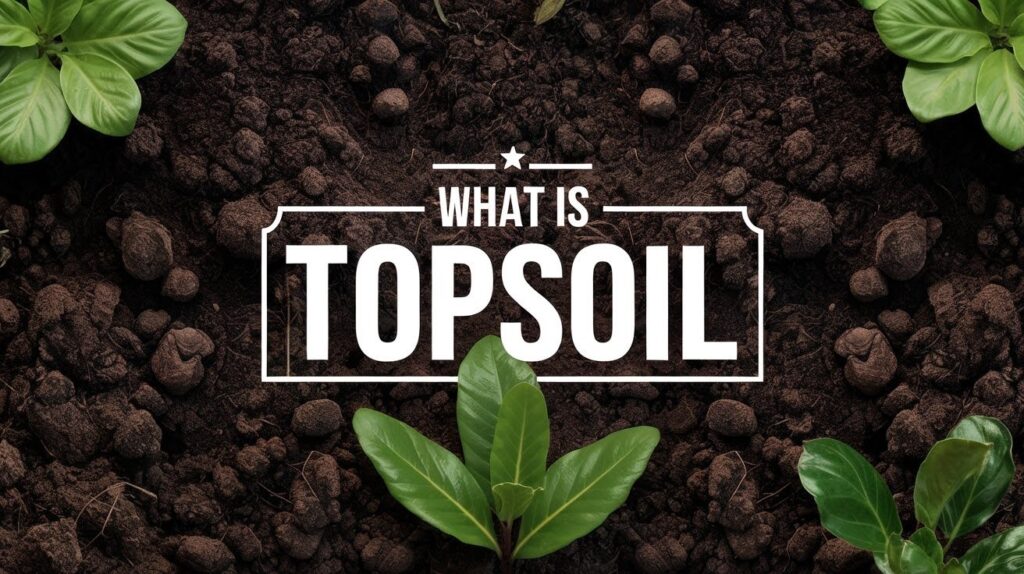Have you ever wondered what makes some gardens thrive while others struggle?
The secret lies right beneath your feet.
Topsoil is that precious uppermost layer of earth, typically spanning 2 to 12 inches deep. Think of it as nature’s pantry – packed with nutrients that feed your plants and make them flourish.
But here’s what’s fascinating: not all topsoil is created equal.
Its makeup tells the whole story. Sand provides drainage. Silt holds moisture. Clay binds everything together. And organic matter? That’s the magic ingredient that turns ordinary dirt into a plant paradise.
Understanding your topsoil’s composition is like having a roadmap to gardening success. It determines what will grow, how much water you need, and which plants will call your yard home.
What Is Topsoil?
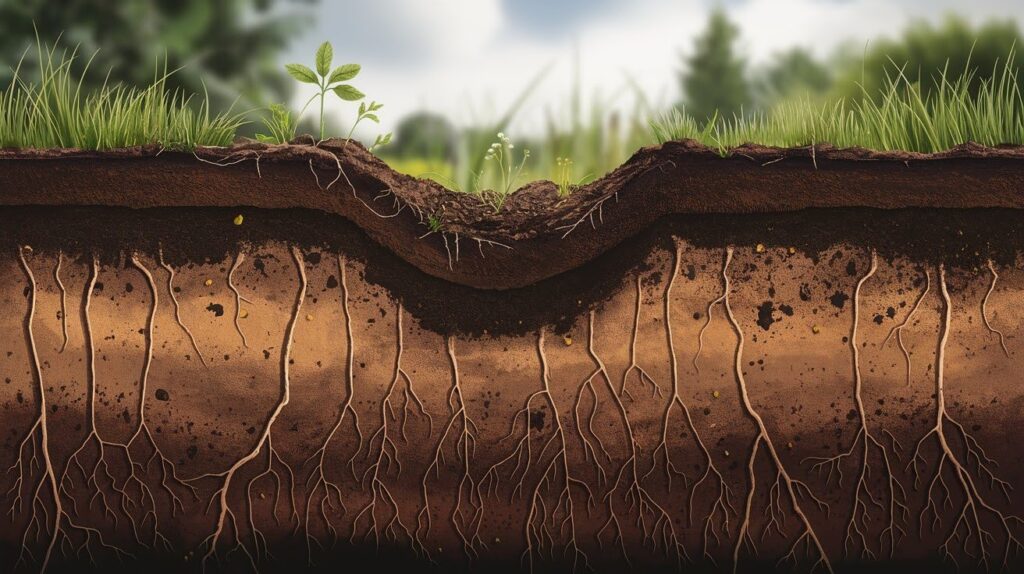
Topsoil is the nutrient-packed surface layer of the earth that feeds plants and forms the foundation of healthy gardens.
Definition
Look outside your window right now.
That rich, dark layer of soil you see? That’s topsoil in action.
It’s the surface layer where life happens. Packed with nutrients that plants crave. Teeming with tiny organisms working around the clock. Full of organic matter from fallen leaves and decomposed plants.
You’ll notice it’s darker than the soil underneath. That deep, chocolate-brown color? It’s a sign of health and fertility.
Composition
Think of topsoil as nature’s perfect recipe.
It starts with the basics: sand for drainage, silt for moisture retention, and clay to hold it all together. Then comes the good stuff – organic matter from decomposed leaves, roots, and plant material.
But wait, there’s more.
Minerals provide essential nutrients. Water carries food to plant roots. Air spaces let roots breathe. Billions of microorganisms break down organic material and create plant food.
The texture matters too. Clay-heavy soil holds water but drains slowly. Sandy soil drains fast but needs frequent watering. Loam? That’s the sweet spot – the perfect balance that most plants love.
Screened vs. Unscreened Topsoil
Here’s where things get practical.
Screened topsoil: goes through processing. It’s sifted and refined. The texture is fine and consistent. Perfect for your lawn, flower beds, and vegetable gardens.
Unscreened topsoil: It’s raw and natural. It’s coarser with chunks of organic matter still intact. Great for filling holes, leveling ground, or construction projects.
Benefits of Topsoil
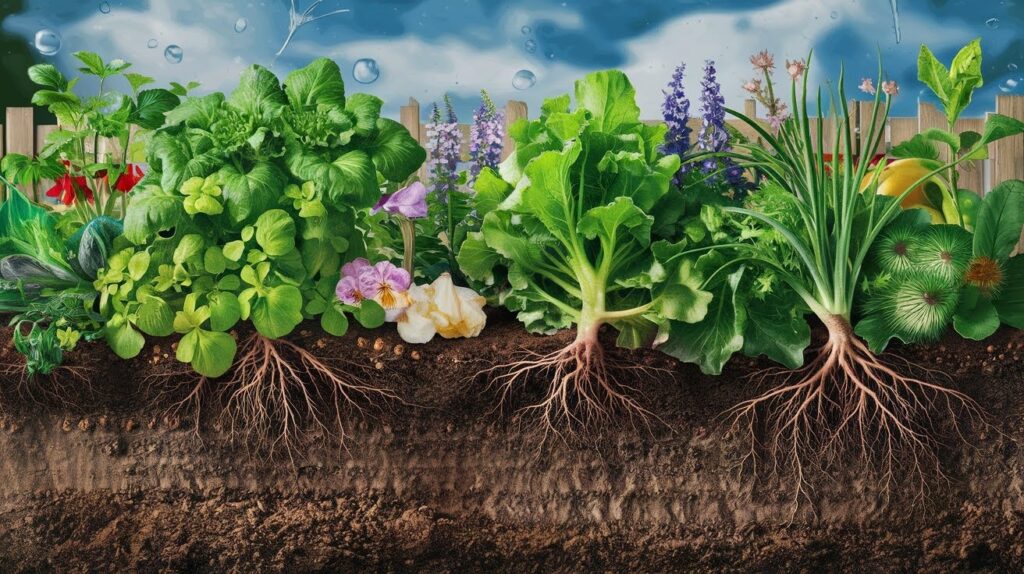
Want to know why gardeners obsess over topsoil?
Here’s the truth.
- It feeds your plants: Topsoil is loaded with nitrogen, phosphorus, and potassium – the holy trinity of plant nutrition. Your vegetables, flowers, and grass depend on these nutrients to grow strong and healthy.
- It manages water like a pro: Good topsoil holds moisture when plants need it. But it also drains excess water to prevent root rot. It’s like having a smart irrigation system built right into your garden.
- Your plant roots will thank you: Loose, rich topsoil gives roots room to spread and breathe. Plants develop stronger root systems in quality topsoil. Stronger roots mean healthier plants above ground.
- It’s alive with helpers: Millions of beneficial bacteria, fungi, and microorganisms call topsoil home. These tiny workers break down organic matter and create plant food. They also protect your plants from harmful diseases.
Think of topsoil as your garden’s life support system.
Without it, you’re just growing plants in dirt.
Common Uses of Topsoil
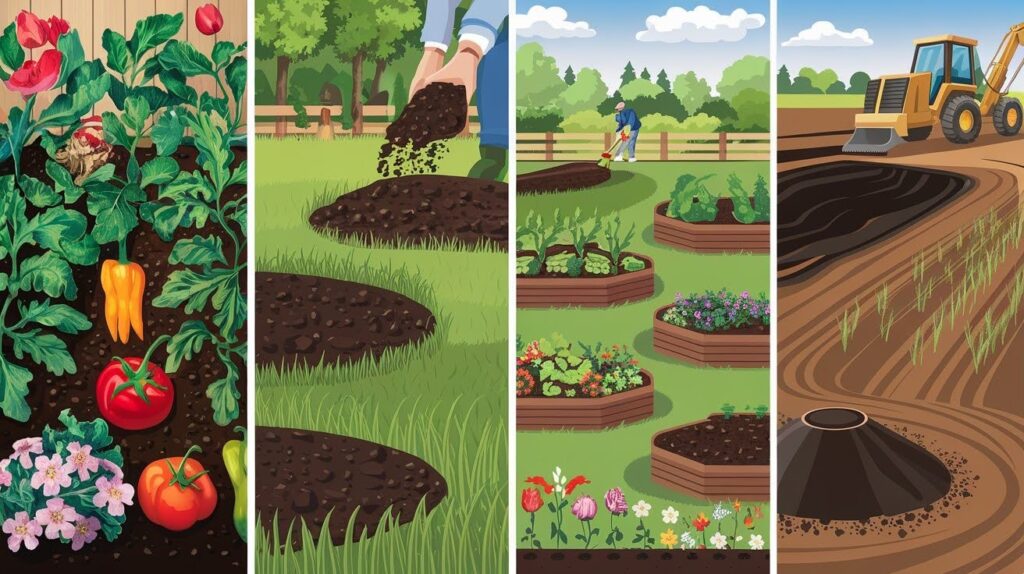
Ready to put topsoil to work?
Let’s see where it shines.
1. Gardening
Your flower beds and vegetable gardens crave rich soil. Topsoil feeds roses, tomatoes, and peppers the nutrients they need for strong growth.
Got poor native soil? Mix topsoil with compost. This combination transforms struggling gardens into thriving ones.
2. Lawn Care
New lawns need the right foundation. Topsoil creates the perfect base for grass roots to establish and spread.
Bare spots and uneven patches ruining your yard? Topsoil levels problem areas and gives new grass a real chance to grow. It loosens compacted soil so water and air reach the roots.
3. Landscaping Projects
Low spots collecting water after rain create problems. Topsoil fills these areas and prevents drainage issues.
Building raised beds? Topsoil provides the rich growing medium plants need. Creating slopes or contoured landscapes? Topsoil molds to your vision while supporting plant life.
4. Construction & Large-Scale Applications
Construction projects need different solutions. Raw, unscreened topsoil works for filling large areas and structural support.
For final planting areas, screened topsoil delivers a smooth, consistent texture. This processed option creates professional-looking results.
How to Apply Topsoil Correctly
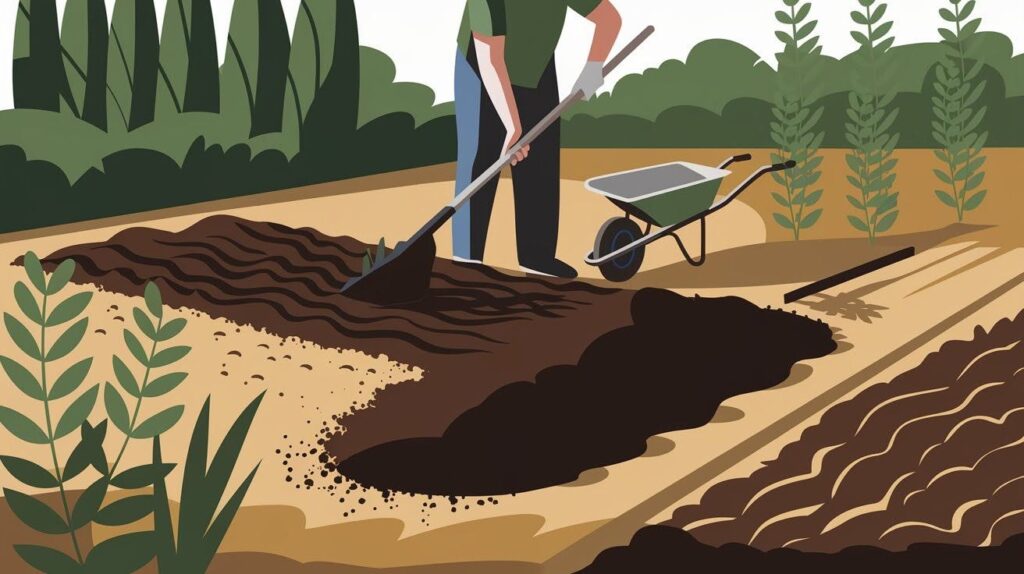
Getting topsoil application right makes all the difference.
Timing matters more than you think. Spring and fall are your best windows for adding topsoil. Spring gives plants the growing season to establish roots in fresh soil.
Fall allows topsoil to settle over winter, ready for next year’s growth.
You don’t need fancy equipment for most projects. A shovel spreads topsoil in flower beds. A rake levels and smooths the surface.
For larger areas, a wheelbarrow saves your back by moving bulk amounts efficiently.
Don’t skip the mixing step. Pure topsoil works fine, but blending creates better results. Mix topsoil with compost for extra nutrients.
Sandy soil draining too fast? Add clay-rich topsoil. Clay soil staying soggy? Mix in sand for better drainage. Match your soil blend to what your plants need.
Topsoil vs. Other Soils
Understanding the differences helps you choose the right soil for your project.
| Soil Type | What It Is | Best Used For |
| Topsoil | Natural surface layer of Earth with nutrients and organic matter | Lawn care, filling areas, and general landscaping projects |
| Garden Soil | Topsoil mixed with added organic matter and amendments | Flower beds, vegetable gardens, and established planting areas |
| Potting Mix | Lightweight, sterilized growing medium designed for containers | Indoor plants, outdoor containers, hanging baskets |
| Compost | Pure decomposed organic matter from plants and food waste | Soil amendment, mixing with other soils for added nutrients |
Each type serves a specific purpose. Topsoil works for most outdoor projects. Garden soil gives you extra nutrition for hungry plants. Potting mix stays light for container growing. Compost acts as a natural fertilizer when mixed with other soils.
Choose based on where and how you’re planting.
Conclusion
After years of working with soil, I can tell you this: topsoil truly is the foundation of everything that grows.
This nutrient-rich surface layer, made up of sand, silt, clay, and organic matter, determines whether your plants thrive or merely survive. I’ve seen struggling gardens transform overnight with quality topsoil application.
Here’s my strongest advice: test your soil before you buy or apply anything new. pH levels, nutrient content, and soil texture tell the real story of what your plants need. Don’t guess when you can know for certain.
Your garden deserves the best foundation you can provide. Quality topsoil isn’t just dirt – it’s an investment in years of healthy, vibrant plant growth.
Frequently Asked Questions
What exactly is topsoil, and how deep does it go?
Topsoil is the nutrient-rich surface layer of the earth that contains organic matter, minerals, and beneficial microorganisms. It typically extends 2 to 12 inches deep and has a darker color compared to the soil layers beneath it.
Can I use regular dirt instead of buying topsoil?
Regular dirt lacks the nutrients and organic matter that plants need to grow properly. Quality topsoil contains essential elements like nitrogen, phosphorus, and potassium that feed your plants and support healthy root development.
How much topsoil do I need for my garden project?
For new garden beds, plan on 2-3 inches of topsoil depth for most plants. Calculate your area in square feet and multiply by the desired depth to determine cubic feet needed – most suppliers sell by the cubic yard.
Should I buy screened or unscreened topsoil?
Screened topsoil works best for lawns, flower beds, and vegetable gardens because of its fine, consistent texture. Unscreened topsoil is better for filling large areas, leveling ground, or construction projects where texture matters less.
When is the best time to add topsoil to my yard?
Spring and fall offer the best conditions for topsoil application. Spring gives plants the full growing season to establish in fresh soil, while fall allows the soil to settle over winter and be ready for next year’s planting.

